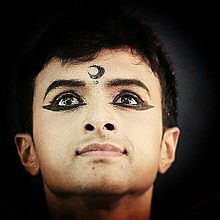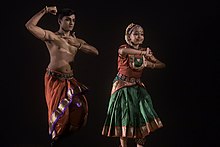Parshwanath Upadhye
Parshwanath S. Upadhye | |
|---|---|
 | |
| Born | Parshwanath Shantinath Upadhye 26 March 1982 |
| Occupation | Dancer |
| Years active | 1996-present |
| Career | |
| Dances | Bharatanatyam |
| Website | www |
Parshwanath Upadhye is an Indian classical dancer, choreographer and teacher.[1][2][3][4][5][6][7] He is trained in the traditional Mysore style of Bharatanatyam.
Along with his wife Shruti Gopal, Parshwanath choreographs, directs, produces and presents his work at national and international venues under the banner of Upadhye School of Dance and Punyah Dance company, Bangalore, India.
Education and training
Parshwanath Upadhye has studied for 15 years in the traditional Mysore style of Bharathanatyam under the guidance of Guru Shri Ravindra Sharma of Belgaum. He completed his Arangetram in the year 1996.
He continued his sadhana with the Guru at Ravind Natya Niketa, Belgaum till the year 2002. He completed his Visharad in Bharatnatyam from Akhil Bharatiya Gandharva Mahavidyalaya Mandal in 1993-94 followed by Alankaara in Bharatnatyam from the same University in the year 2000-2003. He also excelled in the Vidwath Examination in Bharatnatyam conducted by Karnataka Secondary Education Board, Bangalore.
In 1996 he participated in the ‘Karanas’ Workshop conducted by the eminent dancer Guru Dr.Padma Subramanyam at Mangalore. He also had the opportunity to explore Folk music and Dance in the festivals conducted by Bailhongal Janapada Sangha, Karnataka in 1994 -96.
Since 2002 Parshwanath Upadhye learnt from dancer duo, Shri Kiran Subramanyam and Smt.Sandhya Kiran at ‘Rasika Academy of performing Arts,’ Bangalore.[1][5] Now he continues to learn and explore the art form under Padmashri Prof. Sudharani Raghupathy.
Performances and Presentations

Since 1996 Parshwanath Upadhye has danced and participated in numerous festivals and stages in India and abroad.
From 2012 on, he has been choreographing, directing, producing and presenting under Punyah Dance Company Bangalore. Among the works presented at national and international venues are Hara,[8] Sat-gati,[9] Paartha, Punyah Krishna[10][11] and Abha.[12][13][14]
Critical reception
"There are many perfect performers; but very few who can create magic and still less who dance like the gods. Parshwanath Upadhye belongs to the latter class. He has an electrifying persona and stage presence and there is a vein of spirituality that runs through his dance whatever be the content."[15]
-Ranee Kumar, The Hindu
"Upadhye’s interpretation of a devotee’s adoration of Shiva, more specifically at the famous Chidambaram temple, was a sight to behold. His performance was both athletic and graceful. His high kicks, leaps and knee turns did not come at the cost of nuances such as beautifully articulated mudras or clarity of movement in his adavus (basic bharatanatyam dance steps). To top it all off, he kept up the intensity of the dance until the very end, building a sense of crescendo. There were quite a few audible sighs in the audience, who were clearly moved when the devotee was granted audience by Lord Shiva."[10]
-Aparita Bhandari, The Dance Current, Canada's Dance Magazine
"We know Parshwanath Upadhye as a Bharatanatyam soloist from Bangalore[...]. What we were not aware of is that he is a choreographer, and a brilliant one at that. At Kartik Fine Arts, ‘Hara,’ by Parshwanath’s Punyah Dance Company, was a stunning 55-minute production that combined precision in dance movements, perfect timing, layered music, deft visualisation and effective lighting."[14]
- Rupa Srikanth, The Hindu
"For a dancer with a keen sense of rhythm like Parshwanath Upadhye, there is almost no equal in the field. He is the uncrowned prince of the Bharatanatyam scene today and his Facebook page has more followers than those of some minor Bollywood stars"[16]
-Veejay Sai, culture critic
"Parshwanath Upadhye was remarkable both for his striking combination of tandava energy with gentle lasya grace. His dancing demonstrated high technical virtuosity in movement along with a fluidity, precision, and beautiful expression."[17]
-Dr. Ketu H Katrak, Professor of Drama, University of California, Irvine
"Parshwanath's choreography lacks dramatic arc. His face is not emotive and he masks this cleverly with great physicality. Beautifully executed with interesting exits and entrances, the music is typically BENGALURU LITE - a soft-light music-wafting of Carnatic ragas. Against this, the trio's nonstop movement seemed to be a tad too monotonous. The precision, dynamic partnering and team work were admirable. However, after 50 minutes of this endless movement, I longed for some quiet and measured stillness.[18].
-Dr Anita Ratnam, Jan 1, 2019, Anita says...,
"Parshwanath Upadhye needs to bring more gravitas into his Bharatanatyam abhinaya, than the present superficial mime narratives that seem to be his choice. More like theatre, he keeps spinning narratives which lack in-depth treatment, as seen in Baro Krishnaiyyaa and the other composition devoted to Goddess Chamudeswari, where the over spun Kalidasa episode became more like a digression. The starting Hamsadhwani invocation from the Mysore Bharatanatyam repertoire and the Balamurali Krishna Gati Bhed Priya Tillana in Adi talam showed the dancer’s grasp over nritta. With his Yoga expertise, Upadhye moves with ease.[19]
- Leela Venkataraman, Renowned Dance Critic"
The above review appeared in the article "Dance practitioners churn out issues through deliberations". The Asian Age. India: The Asian Age. 15 November 2018. Retrieved 23 May 2019.
"While the theme was good, several aspects of the presentation required thinking. The whole piece was relying heavily on the Sanskrit text and less on dance. The actual dance sequences were far and few. Cluttering too many episodes with a text heavy performance also seemed to slow down the energy of the presentation.[20]
- Veejay Sai, culture critic, Nov 6, 2017, Celebrating the Nartak"
Awards and accolades
Parshwanath Upadhye has received several national awards, including the Sangeet Natak Akademi’s Yuva Puraskar award in 2017.[21] He is also an empanelled artist of the ICCR (Indian Council for Cultural Relations).
List of awards
1. Natya Mayura Award by Gangubai Hangal Trust, Karnataka
2. Arsha Kala Choodamani by Swami Dayananda Saraswati, New Jersey, USA
3. Uttam Kalakaar by Mahamastakaabhisheka Committee, Shravanabelgola
4. Nritya Nipuna by Belli Gajje, Bangalore
5. Arihant Puraskar by Jain Parishat, Kolkata
6. Jain Rashtragaurav by Jain Parishat, Karnataka
7. Natya Keerthi by Aru Shri art centre, Colombo, Sri Lanka
8. CCRT Scholarships for pursuing studies in Bharatnatyam by Ministry of Human Resources Development, Govt. of India
9. Natya Prabha award by The Sabha Kuwait 2016
10. Ustad Bismillah Khan Yuva Puraskar 2017 by Sangeet Natak Akademi, New Delhi[21]
11. Awarded as the best performer of the year 2017 by Music Academy, Chennai[22]
12. "Kala Kiran puraskar" by Adithya Birla foundation Mumbai 2018
13."Rasika Hridaya Chora" by Sridevi Natyalaya Chennai 2018
Teaching
Parshwanath Upadhye started teaching Bharatanatyam in 1996 when he established the Sharada Sangeetha Nrithya Academy, Belgaum, of which he was also the Director till the year 2000.
In 2010 he established the Upadhye School[23] of Dance in Bangalore of which he is the Director, Chief Choreographer and Performer .
References
- ^ a b Nainar, Nahla (7 September 2018). "Dancing to the divine melody". The Hindu. ISSN 0971-751X. Retrieved 25 January 2020.
- ^ Mathur, Yashika (5 March 2019). "A mudra of perfection". Deccan Chronicle. Retrieved 25 January 2020.
- ^ Nampoothiri, Hareesh N. (7 June 2018). "'It's important for an artiste to know the audience'". The Hindu. ISSN 0971-751X. Retrieved 25 January 2020.
- ^ "Dance like a man". The Indian Express. 6 June 2014. Retrieved 25 January 2020.
- ^ a b Arya UR (6 February 2018). "Parshwanath Upadhye: 'Dance is challenging only when you are into it for name and fame'". The Times of India. Retrieved 25 January 2020.
- ^ Nainar, Nahla (4 September 2018). "When mudras flowed with fluid grace and energy". The Hindu. ISSN 0971-751X. Retrieved 25 January 2020.
- ^ "Parshwanath Upadhye the Male Soloist". All About Belgaum. 18 April 2011. Retrieved 5 July 2014.
- ^ "Report - Hara: When the Gods dance - An analytical report - Ramaa Bharadvaj". narthaki.com. Retrieved 25 January 2020.
- ^ Kumar, Bhanu (12 April 2018). "In idioms, classical and contemporary". The Hindu. ISSN 0971-751X. Retrieved 25 January 2020.
- ^ a b "A New Spin on an Old Classic". The Dance Current. Retrieved 25 January 2020.
- ^ "Sampradaya Dance Creations presents Parshwanath Upadhye in Punyah Krishna July 15th and 16ht at the Sampradaya Theatre". Dance Umbrella of Ontario. 11 July 2017. Retrieved 25 January 2020.
- ^ "Review - Dream premiere for Punyah Dance Company's Abha - Satish Suri". narthaki.com. Retrieved 25 January 2020.
- ^ Nampoothiri, Hareesh N. (13 June 2019). "Vibrant exposition of the Ramayana". The Hindu. ISSN 0971-751X. Retrieved 25 January 2020.
- ^ a b Srikanth, Rupa (12 January 2017). "The stage comes alive". The Hindu. ISSN 0971-751X. Retrieved 25 January 2020.
- ^ Kumar, Ranee (28 April 2017). "F ine footwork to the fore". The Hindu. ISSN 0971-751X. Retrieved 25 January 2020.
- ^ Sai, Veejay (21 April 2017). "The next generation of dancing stars". Livemint. Retrieved 25 January 2020.
- ^ "Review - The primacy of male and female energies in the Dancing Male - Dr. Ketu H. Katrak". narthaki.com. Retrieved 25 January 2020.
- ^ "Anita says...January 2019". www.narthaki.com. Retrieved 22 May 2019.
- ^ "Dance practitioners churn out issues through deliberation". www.asianage.com. Retrieved 22 May 2019.
- ^ "Review - Celebrating the Nartaka - Veejay Sai". www.narthaki.com. Retrieved 22 May 2019.
- ^ a b "Archived copy" (PDF). Archived from the original (PDF) on 25 September 2018. Retrieved 24 September 2018.
{{cite web}}: CS1 maint: archived copy as title (link) - ^ "Review - Music Academy Dance Festival 2018 Memorable Mornings - the best of the lot - Veejai Sai".
- ^ "Parshwanathupadhye".
